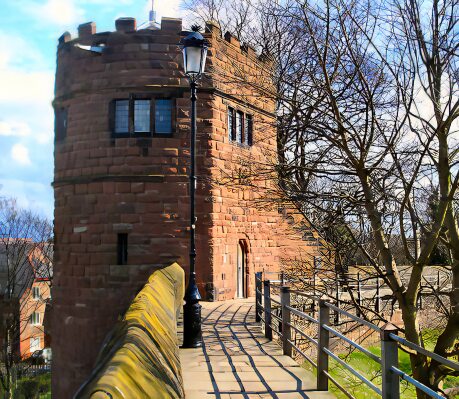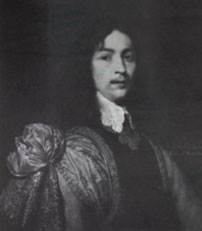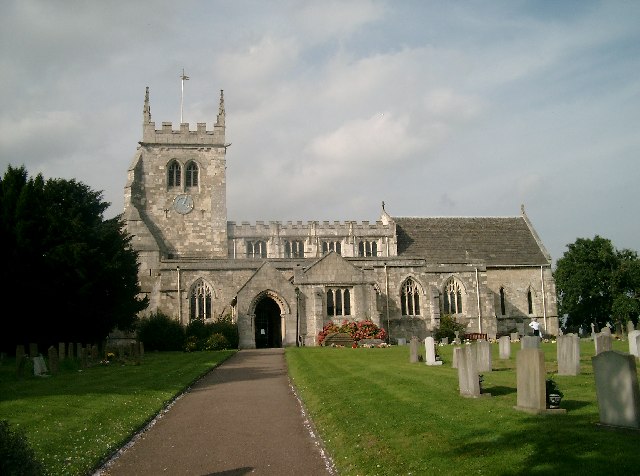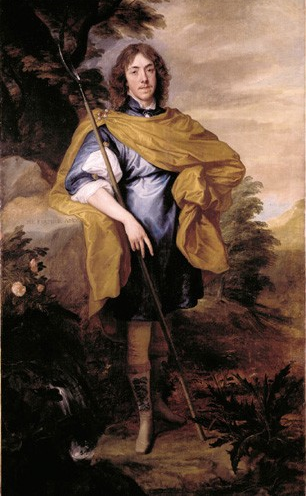 Lord John and Lord Bernard Stuart, two brothers who died in the English Civil War by Anthony van Dyck c 163The Battle of Rowton Heath occurred on 24 September 1645 during the English Civil War between the Parliamentarians, commanded by Sydnam Poyntz, (an English soldier, served in the Thirty Years' War under Ernst von Mansfeld before commanding
Lord John and Lord Bernard Stuart, two brothers who died in the English Civil War by Anthony van Dyck c 163The Battle of Rowton Heath occurred on 24 September 1645 during the English Civil War between the Parliamentarians, commanded by Sydnam Poyntz, (an English soldier, served in the Thirty Years' War under Ernst von Mansfeld before commanding  Parliamentary forces in theEnglish Civil War.
Parliamentary forces in theEnglish Civil War.
Sydenham was the fourth son of John Poyntz of Reigate, Surrey, and his wife Ann. He ran away from an apprenticeship to a London tradesman and became a mercenary, fighting for the Imperial Spanish army under Mansfeld during the Thirty Years' War and rising to the rank of Major General.
and his wife Ann. He ran away from an apprenticeship to a London tradesman and became a mercenary, fighting for the Imperial Spanish army under Mansfeld during the Thirty Years' War and rising to the rank of Major General.
 and his wife Ann. He ran away from an apprenticeship to a London tradesman and became a mercenary, fighting for the Imperial Spanish army under Mansfeld during the Thirty Years' War and rising to the rank of Major General.
and his wife Ann. He ran away from an apprenticeship to a London tradesman and became a mercenary, fighting for the Imperial Spanish army under Mansfeld during the Thirty Years' War and rising to the rank of Major General.
In 1645, Poyntz returned to England and entered service with Parliamentary forces in the English Civil War. Poyntz's forces defeated those of Charles I of England at Rowton Heath. Chester City Wall where King Charles I watched the Battle of Rowton Heath and the 14th century round Water Tower at the end of a spur wall.
Chester City Wall where King Charles I watched the Battle of Rowton Heath and the 14th century round Water Tower at the end of a spur wall.
By 1647, Poyntz was drawn onto Parliament's side of the dispute between it and Oliver Cromwell's New Model Army. New Model Army commander Fairfax mistrusted Poyntz and placed spies in Poyntz's camp to foment distrust. Poyntz fled the country when London fell to Army troops. He wrote The Relation of Sydnam Poyntz 1624-1636, an account of his German experiences.)and the Royalists under the personal command of King Charles I. The result was a significant defeat for the Royalists, with heavy losses and Charles prevented from relieving the Siege of Chester. Chester City Wall where King Charles I watched the Battle of Rowton Heath and the 14th century round Water Tower at the end of a spur wall.
Chester City Wall where King Charles I watched the Battle of Rowton Heath and the 14th century round Water Tower at the end of a spur wall. morgans mount chester
morgans mount chesterPrior to the battle, Charles had been attempting to link up with the Marquess of Montrose in Scotland following the Royalist defeat in the Battle of Naseby.
in Scotland following the Royalist defeat in the Battle of Naseby.  Although his attempts to do so were unsuccessful, they were disruptive enough that theCommittee of Both Kingdoms ordered Sydnam Poyntz to pursue the King with approximately 3,000 horse. After Charles was informed that Chester, his only remaining port, was under siege, he marched there with the intent of relieving the defenders, ordering 3,000 horse under the command of Marmaduke Langdale
Although his attempts to do so were unsuccessful, they were disruptive enough that theCommittee of Both Kingdoms ordered Sydnam Poyntz to pursue the King with approximately 3,000 horse. After Charles was informed that Chester, his only remaining port, was under siege, he marched there with the intent of relieving the defenders, ordering 3,000 horse under the command of Marmaduke Langdale to camp outside the city while he and 600 others travelled into Chester itself on 23 September 1645. The intent was to attack the besieging Parliamentarians from both sides, Charles mistakenly believing that Poyntz had failed to follow them. In fact he was barely 15 miles (24 km) behind, and moved to attack Langdale's force in the early hours of 24 September. Although Langdale drove Poyntz off, the Parliamentarians besieging Chester sent reinforcements, and Langdale was forced to retreat to Rowton Heath, closer to Chester, and wait for his own reinforcements. This force, under Charles Gerard
to camp outside the city while he and 600 others travelled into Chester itself on 23 September 1645. The intent was to attack the besieging Parliamentarians from both sides, Charles mistakenly believing that Poyntz had failed to follow them. In fact he was barely 15 miles (24 km) behind, and moved to attack Langdale's force in the early hours of 24 September. Although Langdale drove Poyntz off, the Parliamentarians besieging Chester sent reinforcements, and Langdale was forced to retreat to Rowton Heath, closer to Chester, and wait for his own reinforcements. This force, under Charles Gerard and Lord Bernard Stewart,
and Lord Bernard Stewart, was prevented from joining them, and Langdale was instead attacked by both Poyntz's force and the reinforcement. After being driven off the field and failing in an attempt to regroup at Chester itself, the Royalists retreated as dusk fell.
was prevented from joining them, and Langdale was instead attacked by both Poyntz's force and the reinforcement. After being driven off the field and failing in an attempt to regroup at Chester itself, the Royalists retreated as dusk fell.
 in Scotland following the Royalist defeat in the Battle of Naseby.
in Scotland following the Royalist defeat in the Battle of Naseby.  Although his attempts to do so were unsuccessful, they were disruptive enough that theCommittee of Both Kingdoms ordered Sydnam Poyntz to pursue the King with approximately 3,000 horse. After Charles was informed that Chester, his only remaining port, was under siege, he marched there with the intent of relieving the defenders, ordering 3,000 horse under the command of Marmaduke Langdale
Although his attempts to do so were unsuccessful, they were disruptive enough that theCommittee of Both Kingdoms ordered Sydnam Poyntz to pursue the King with approximately 3,000 horse. After Charles was informed that Chester, his only remaining port, was under siege, he marched there with the intent of relieving the defenders, ordering 3,000 horse under the command of Marmaduke Langdale to camp outside the city while he and 600 others travelled into Chester itself on 23 September 1645. The intent was to attack the besieging Parliamentarians from both sides, Charles mistakenly believing that Poyntz had failed to follow them. In fact he was barely 15 miles (24 km) behind, and moved to attack Langdale's force in the early hours of 24 September. Although Langdale drove Poyntz off, the Parliamentarians besieging Chester sent reinforcements, and Langdale was forced to retreat to Rowton Heath, closer to Chester, and wait for his own reinforcements. This force, under Charles Gerard
to camp outside the city while he and 600 others travelled into Chester itself on 23 September 1645. The intent was to attack the besieging Parliamentarians from both sides, Charles mistakenly believing that Poyntz had failed to follow them. In fact he was barely 15 miles (24 km) behind, and moved to attack Langdale's force in the early hours of 24 September. Although Langdale drove Poyntz off, the Parliamentarians besieging Chester sent reinforcements, and Langdale was forced to retreat to Rowton Heath, closer to Chester, and wait for his own reinforcements. This force, under Charles Gerard and Lord Bernard Stewart,
and Lord Bernard Stewart, was prevented from joining them, and Langdale was instead attacked by both Poyntz's force and the reinforcement. After being driven off the field and failing in an attempt to regroup at Chester itself, the Royalists retreated as dusk fell.
was prevented from joining them, and Langdale was instead attacked by both Poyntz's force and the reinforcement. After being driven off the field and failing in an attempt to regroup at Chester itself, the Royalists retreated as dusk fell.
Royalist casualties were high, with 600 killed, including Stewart, and 900 taken prisoner. This defeat prevented Charles from relieving the defenders in Chester,the photos are from the great blog glorious little soldiers which fell to the Parliamentarians on 3 February 1646. Charles instead withdrew with approximately 2,400 remaining cavalry, most of whom were destroyed by Poyntz's ambush at Sherburn-in-Elmet
which fell to the Parliamentarians on 3 February 1646. Charles instead withdrew with approximately 2,400 remaining cavalry, most of whom were destroyed by Poyntz's ambush at Sherburn-in-Elmet  on 15 October 1645.Lord Bernard Stewart (1623 – 26 September 1645) was a Scottish aristocrat who served as a Royalist commander in the English Civil War. He was the youngest of five sons of Esmé Stewart, 3rd Duke of Lennox and his wife Katherine Clifton, 2nd Baroness Clifton, and the brother of James Stewart, 1st Duke of Richmond.
on 15 October 1645.Lord Bernard Stewart (1623 – 26 September 1645) was a Scottish aristocrat who served as a Royalist commander in the English Civil War. He was the youngest of five sons of Esmé Stewart, 3rd Duke of Lennox and his wife Katherine Clifton, 2nd Baroness Clifton, and the brother of James Stewart, 1st Duke of Richmond.
 which fell to the Parliamentarians on 3 February 1646. Charles instead withdrew with approximately 2,400 remaining cavalry, most of whom were destroyed by Poyntz's ambush at Sherburn-in-Elmet
which fell to the Parliamentarians on 3 February 1646. Charles instead withdrew with approximately 2,400 remaining cavalry, most of whom were destroyed by Poyntz's ambush at Sherburn-in-Elmet  on 15 October 1645.Lord Bernard Stewart (1623 – 26 September 1645) was a Scottish aristocrat who served as a Royalist commander in the English Civil War. He was the youngest of five sons of Esmé Stewart, 3rd Duke of Lennox and his wife Katherine Clifton, 2nd Baroness Clifton, and the brother of James Stewart, 1st Duke of Richmond.
on 15 October 1645.Lord Bernard Stewart (1623 – 26 September 1645) was a Scottish aristocrat who served as a Royalist commander in the English Civil War. He was the youngest of five sons of Esmé Stewart, 3rd Duke of Lennox and his wife Katherine Clifton, 2nd Baroness Clifton, and the brother of James Stewart, 1st Duke of Richmond.
Lord Bernard was to be created Earl of Lichfield by King Charles I for his actions at the battles of Newbury and Naseby but died of injuries received leading a sortie against besieging Parliamentary forces in the Battle of Rowton Heath in September 1645, before the patent could be implemented. The titles of Baron Newbury and Earl of Lichfield were instead created in December 1645 for his six-year-old nephew, Charles Stewart (1639–1672), the son of Bernard's elder brother George Stewart, 9th Seigneur d'Aubigny,
in September 1645, before the patent could be implemented. The titles of Baron Newbury and Earl of Lichfield were instead created in December 1645 for his six-year-old nephew, Charles Stewart (1639–1672), the son of Bernard's elder brother George Stewart, 9th Seigneur d'Aubigny, who had been killed at the Battle of Edgehill in 1642. His brother John was also killed in the war.
who had been killed at the Battle of Edgehill in 1642. His brother John was also killed in the war.
 in September 1645, before the patent could be implemented. The titles of Baron Newbury and Earl of Lichfield were instead created in December 1645 for his six-year-old nephew, Charles Stewart (1639–1672), the son of Bernard's elder brother George Stewart, 9th Seigneur d'Aubigny,
in September 1645, before the patent could be implemented. The titles of Baron Newbury and Earl of Lichfield were instead created in December 1645 for his six-year-old nephew, Charles Stewart (1639–1672), the son of Bernard's elder brother George Stewart, 9th Seigneur d'Aubigny, who had been killed at the Battle of Edgehill in 1642. His brother John was also killed in the war.
who had been killed at the Battle of Edgehill in 1642. His brother John was also killed in the war.
No comments:
Post a Comment